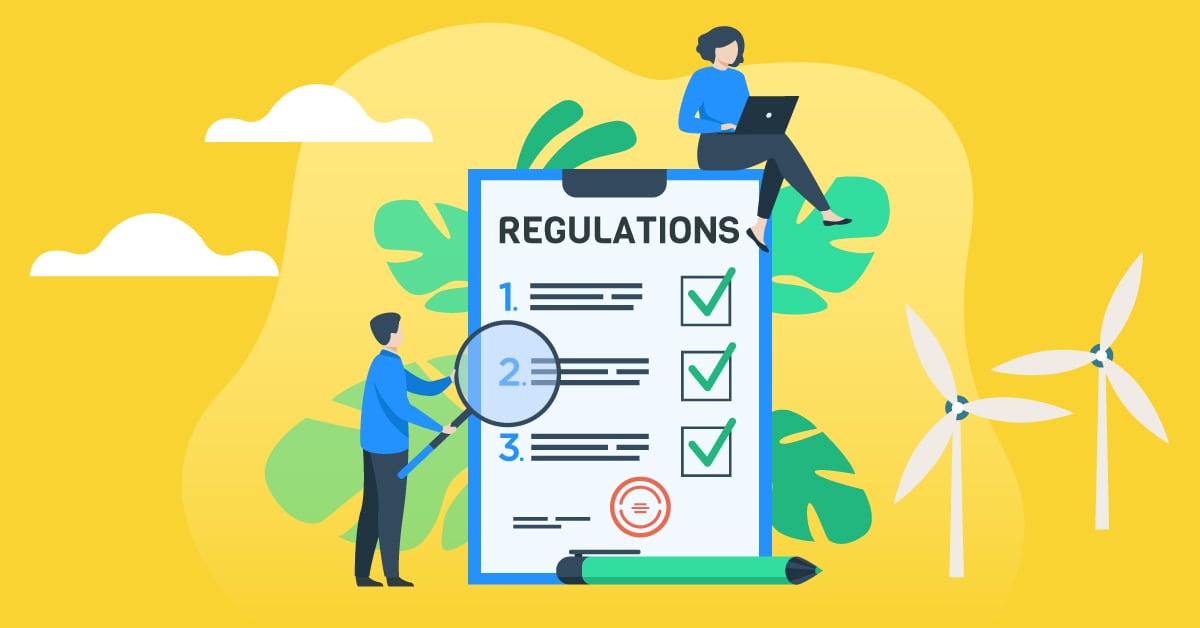Written by Landytech
4 Jul 2022There has been an explosion in the popularity of environmental, social, and governance funds in recent years. In light of this growth, fund managers have been increasingly keen to step up their commitment to ESG and its measurement.
The rewards for those that get it right are high. An authentic ESG strategy that is evident through a firm’s products, their investment process and data-driven reporting is easy for existing investors to understand and attractive to prospects that value ESG highly.
Asset managers must demonstrate that their fund disclosures and reporting approach meets parameters which are strictly linked to ESG reporting criteria. But reporting is not an easy landscape to navigate when it comes to ESG.
The EU has started to implement the Sustainable Finance Disclosure Regulation (SFDR), which sets out rules for classifying and reporting on sustainability and ESG factors in investments. But whilst regulators and industry bodies across the globe play catch up, there has been a distinct lack of guidance for asset managers compared to other more established investment reports.
Despite this ambiguity, there are three principles ESG reports should adhere to: authenticity, substance and defendable data. Asset managers need to be transparent on the methodological approach followed in their investment strategy, implementation of governance and the reporting in place.
Today, most asset managers have several options to demonstrate the transparency and accountability of their ESG funds. But how these are implemented for reporting depends on the ESG strategy in place, and the jurisdiction in which the asset manager is operating.
Identifying and defining ESG activities and strategies
There are several ways an asset manager can incorporate ESG considerations into a fund strategy:
- Regulatory alignment – This approach involves implementing ESG strategies that align with ESG regulation of the jurisdiction within which the fund is operating. The most notable of example of this is SFDR within the EU.
- SFDR Article 8 - is where funds promote investments or projects with positive environment or social characteristics and with good governance principles, alongside other non-ESG traits. While sustainable investment is not an objective of the product, it remains an aspect of the investment process.
- SFDR Article 9 - covers products that target a sustainable investment primary objective. A sustainable investment is an economic activity that contributes to an environmental or social objective. Products must comply with the ‘do no significant harm’ principle which means proving that the product does not in any way significantly harm any of the EU Taxonomy objectives.
- Best-in-class – This approach includes finding the companies that are leaders in their sector in terms of meeting environmental, social and governance criteria.
- Exclusions - This approach excludes specific investments such as companies, sectors, or countries based on specific criteria. Common categories include weapons, pornography, tobacco and animal testing.
- Sustainability-themed - This approach involves investment in themes or assets linked to the development of sustainability. Funds can focus on individual or multiple issues related to ESG. Sustainability-themed investments contribute to addressing social and/or environmental challenges such as climate change, energy efficiency and health outcomes. Funds are required to have an ESG analysis or screen of investments in order to be counted in this approach, which can be performed by specialised ESG label providers.
- Norms-based screening – This is the screening of investments according to their compliance with international standards and norms, and is one of the most commonly employed approaches. These include adherence to the UN Global Compact, Kyoto Protocol, UN Declaration of Human Rights etc.
- ESG integration - This approach involves the explicit inclusion of ESG risks and opportunities in traditional financial analysis and investment decisions based on a systematic process and research. ESG integration means managers need to understand the potential impact of ESG issues on company financials, which may affect their decision to invest.
- Environmental issues relate to aspects of a company’s activity that affects the environment in a positive or negative way. Examples include gas emissions, energy efficiency, resource depletion, pollution levels and the company’s impact on biodiversity.
- Social issues address various community-related aspects, such as the improvement of health and education, to workplace-related issues, including the adherence to human rights, non-discrimination, and stakeholder engagement. Examples of such issues include labour standards, relations with local communities and approaches to talent management.
- Governance issues concern the quality of a company’s management, culture and risk profile, among others. This includes board accountability and strategic management of social and environmental performance. It emphasises principles such as transparent reporting and the carrying out of management tasks in a manner that is free of abuse and corruption. Examples include corporate governance, bribery, corruption, stakeholder dialogue or lobbying activities.
Defining ESG strategy from the outset
Asset managers should use pre-sales documentation to lay out the ESG principles followed as part of the investment policy of the relevant fund. This section should describe the objectives followed in plain language.
Where previously it had only been best practice to provide this information, in the EU this has now become a regulatory obligation, with other countries set to follow suit. Under SFDR, UCITS and AIFMs must designate investment products as an Article 6, 8 or 9 fund, and make certain disclosures in-keeping with this choice. Fund managers must disclose how they integrate sustainability risks into investment decision making as well as the adverse sustainability impacts of the funds’ investments. These pre-contractual disclosures are required to ensure that investors have greater transparency before entering an investment product or accepting advice.
Asset managers should provide supplemental ESG-relevant information through their website, prospectus, factsheet documentation or any other type of ESG policy documentation. The pre-sales documentation should lay out clearly how any ESG approaches been implemented and will continue to be followed, to ensure that investors are given a comprehensive picture.
Evaluating relevant reporting categories and performance indicators
The type of information that is relevant to asset managers depends on the ESG investment approach The following could be reported as a minimum for each strategy:
- Regulatory alignment – Make disclosures and meet reporting requirements in keeping with regulatory obligations. Under SFDR Articles 8, and 9 this includes disclosing that the fund is complying with ESG considerations outlined by the article choice.
- Best-in-class - Average ESG-rating of the portfolio or sectors within the portfolio
- Exclusions - Regular commitment to reviewing and updating the exclusions list, as well as updates to progress towards divestment
- Sustainability-themed - The amount of the portfolio invested in the sustainability themes pursued
- Norms-based screening - The amount of the portfolio invested in line with the selected norms
- ESG-integration - Investment decisions and/or the relating investment value impacted by ESG considerations. Usually this is evidenced by analysis conducted either in-house or by sustainable finance market players.
Establishing internal data processes and collecting data
Asset managers can collect data on their ESG strategy through internal processes. Another approach is sourcing publicly disclosed information from companies in their portfolio, aggregating it and compiling a sustainability-themed portfolio report. To do so, asset managers should aggregate the data relative to the weight of the companies in the portfolio.
To estimate the impact of their portfolio, asset managers can make use of data providers that offer ESG impact conversion factors. Such factors are sector-specific and have been developed by aggregating reported impact information and comparing such information against investment in that sector. The result is a factor that is descriptive of impact per unit of currency invested in a specific sector (e.g. greenhouse gas emissions per $ million invested). Asset managers can apply these factors to their portfolio and estimate their impact for reporting purposes.
Deciding on the reporting format and frequency
It is common practice for asset managers to publish reports to investors on a monthly or quarterly basis, at the very least . As investor demands for transparency increase, the more frequent the reporting the better. Greater reporting frequency, without the operational burden, can be achieved with investment reporting software.
Asset managers will need to assess their existing reporting cycle and publications in order to identify whether information on sustainable financial products is best reported as part of, or separate to, existing reporting structures.
For firms that operate in the EU to be able to market investments as Article 8 or 9, they will need to review the whole lifecycle of products, from the initial product development and marketing, through to monitoring and reporting, updating policies and processes accordingly. EU-based asset managers can then choose to provide supplemental ESG-relevant information via their website, prospectus, factsheets and other types of ESG-dedicated documentation.
Related Content

The data problem behind SFDR reporting and disclosures
SFDR is one of the largest pieces of ESG-related legislation rolled out anywhere in the world, and their compliance requirements are a daunting prospect for fund managers and wider financial market participants.
Under Level 1 of SFDR, market...

4 top trends driving the ESG reporting agenda in 2022
Interest in ESG has increased exponentially in recent years and there has been no sign of slowing in 2022, so far. But it is not just inflows to ESG funds that has been increasing. As policymakers turn their attention to environmental, social, and...

SFDR Article 6, 8 and 9 products explained. What do the classifications mean?
The EU has started to implement the Sustainable Finance Disclosure Regulation (SFDR), which sets out rules for classifying and reporting on sustainability and ESG factors in investments.
Forming part of the EU Financing Sustainable Growth Action...




